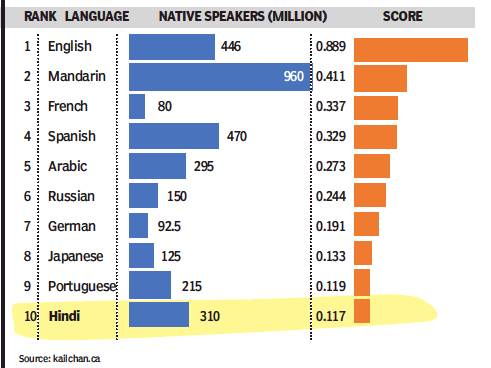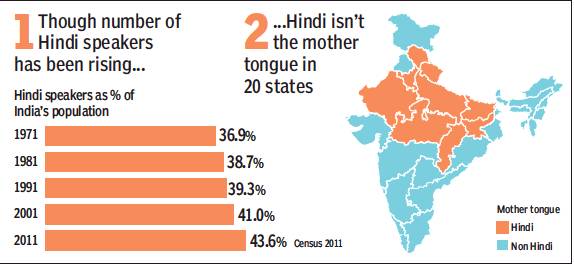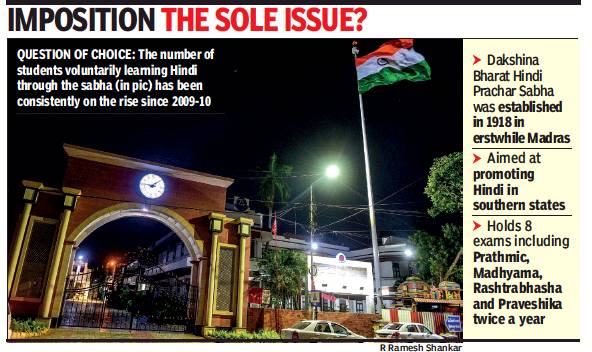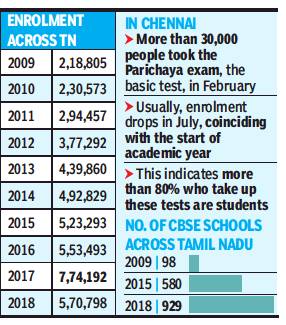Hindi language, the spread of
This is a collection of articles archived for the excellence of their content. |
Contents |
Global power
No. 10 in 2018
December 2, 2018: The Times of India

From: December 2, 2018: The Times of India
7,000 Estimated number of captive tigers — pets and zoo animals — in the US. It’s roughly double the world’s wild tiger population
English is world’s most powerful language, movies help Hindi finish at 10th place
How do we decide which is the world’s most powerful language? Should we go by the number of native speakers, or a language’s role in the global economy? Why not consider the geographical area over which a language is spoken, or its usefulness in diplomacy? But none of these parameters is enough by itself. So, Kai L Chan, a distinguished fellow at the French business school Insead, has developed a ‘Power Language Index’ that weighs each language’s influence over geography, economy, communication, knowledge & media, and diplomacy.
All things considered, English finishes first with a weighted score of 0.889 (out of 1), topping all five categories even though it has the third highest number of native speakers. Mandarin is a distant second. Hindi finishes 10th overall, but is second in the ‘knowledge & media’ category because of the large number of Hindi films made.
The population that speaks Hindi
1971-2011

From: Manash Gohain, June 4, 2019: The Times of India
See graphic:
Hindi speakers as % of India's population, 1971-2011
AP, Telangana
1884, 1918, 1952
Syed Akbar, June 9, 2019: The Times of India
Why Hindi is no tongue-twister for Telugus in AP
Hyderabad:
In 1952, when the Union government under Jawaharlal Nehru moved a proposal to make Osmania University into a central university with Hindi as the medium of instruction, students came out and protested in large numbers. They were not upset over Urdu or even Telugu being undermined. They were upset over the possibility of English no longer being the medium of instruction.
This is rare instance of Hindi ruffling feathers in the Teluguspeaking states, but for a completely different reason. The Centre may have acted quickly to defuse a possible volatile situation in certain states over the new National Education Policy (NEP), but the “imposition” of Hindi has never been an issue in Andhra Pradesh and Telangana. While neighbouring Tamil Nadu and Karnataka witnessed trouble in the past over making Hindi compulsory in school education, Andhra Pradesh and Telangana had largely welcomed the language. Hindi is taught in almost all schools in Hyderabad.
Experts attribute several factors, including historical and geographical, for the “friendly” attitude of the Telugu-speaking people towards Hindi. Also, Telugu speakers never felt threatened by Hindi as the region (AP and Telangana) had always been bilingual or even multilingual, unlike other southern states like Tamil Nadu, Kerala and Karnataka, where only a single language is spoken.
When Osmania University was set up in 1918, exclusive departments were opened for Sanskrit, Telugu, Persian, Arabic and Urdu. Later, Kannada and Marathi departments were added. The Nizam’s currency had four languages, including Telugu, printed on it. The Qutub Shahis, who founded Hyderabad, had named their gold coins after the Telugu term, Hun, meaning gold. Some of them spoke Telugu, and Mohammad Quli Qutub Shah, who built Charminar and founded Hyderabad, was himself a poet in Telugu, though his mother tongue was Persian.
Nevertheless, language had been a trigger for protests even in Telugu states if a few past incidents were any indication. There was a strong resistance when the Nizam VI, Mir Mahbub Ali Khan, changed the official language of princely Hyderabad state from Persian to Urdu on February 21, 1884. There was also opposition to Urdu as the medium of instruction in Osmania University.
The Nehru government had in 1952 withdrawn its proposal to convert Osmania into a central university and Hindi as the main language following the strong protests. Interestingly, Urdu was officially the medium of instruction in the university at the time. However, after the police action in 1948, teachers were informally told to take classes in English which then became the informal medium of instruction. Any attempt to change the language yet again four years on was unacceptable to the students.
At the same time, the scale of the protest in AP and Telangana was never as large as seen in Tamil Nadu whenever there was a talk of Hindi imposition.
Historically, common capital Hyderabad has always been a cosmopolitan city with people of different languages and cultures coexisting right from the day of its birth in 1591 CE. It had people speaking Telugu, Persian, Dakkani, Urdu, Marathi and Kannada. Another factor for lack of strong protests over Hindi imposition in Telugu states was that Telugu leaders had always shown more interest in geography than in language. Even during the just concluded general elections, Telugu Desam Party (TDP) president N Chandrababu Naidu had harped on the Andhra pride, a geo-anthropological factor, rather than on the Telugu language. His campaign centred around the assumed threat of dominance by Telangana leaders over the Andhras.
Status in India, state-wise
Tamil Nadu
2001-11, increase in speakers: South: 13%; TN: 50%; decline among Kannadigas
Tamil Nadu, which has long opposed the “imposition” of Hindi in the state, saw a rise of 50% Hindi speaker among Tamilians between 2001 and 2011, according to the latest census data. Overall, the percentage of Hindispeaking south Indians, however, rose by only 13% during the same period, and even declined among Kannadigas.
The anti-Hindi agitation of the 1960s led to several generations of Tamilians not learning the language. Things have changed with large scale migration of people from India’s north, north-east and northwest as blue collar and white collar workers.
“The absolute number of Tamilians speaking Hindi might be small. But given the current preference for CBSE and ICSE schools, more students could be opting for Hindi as second and third language. Also those looking for jobs outside Tamil Nadu may be learning Hindi,” said international population expert P Arokiasamy.
“There are several reasons for Tamilians learning Hindi. Migration is one, but TV programmes also influence Tamil people. The shift started when the Ramayana and the Mahabharata were telecast,” said sociologist G S Karanth.
All Tamilians speaking Hindi are not conversant with the language; many mix a bit of Tamil, English and Hindi and are able to convey what they want to say. “An autorickshaw driver may not be a Hindi pundit but if he can convey to his passenger in broken Hindi the charge for the ride, the route etc., the work is done. Thus learning Hindi also means increasing a person’s income in changed circumstances,” said Karanth. “Many company bosses are from the north and they only speak Hindi. Unless you learn Hindi, it will be difficult to work under them,” he said.
2016
See graphic:
Hindi in TN in 2016
2009-18: no. of students learning Hindi rises
Ram Sundaram, June 9, 2019: The Times of India

From: Ram Sundaram, June 9, 2019: The Times of India

From: Ram Sundaram, June 9, 2019: The Times of India
No. of students learning Hindi in TN rising as CBSE schools mushroom
Parents Feel Tamil And English Aren’t Enough, Want Better Career Opportunities For Kids
The three-language formula included in the draft new national education policy may have raised the hackles of politicians in Tamil Nadu, but the number of people learning Hindi in the state has been steadily increasing, particularly with the mushrooming of CBSE-affiliated schools, suggesting that the problem is not with learning the language but in forcing it on students.
The number of students voluntarily learning Hindi through the Dakshina Bharat Hindi Prachar Sabha, launched in 1918 to promote the laguage in the south, has been consistently on the rise since 2009-10 when Samacheer Kalvi (uniform state syllabus) was made mandatory and CBSE schools began flourishing because of the better syllabus. From just 98 schools 10 years ago, there are now more that 950 institutions permanently affiliated to the Central Board of Secondary Education (CBSE) in the state and a thousand others with temporary affiliation. In the same period, the number of candidates appearing for exams conducted by the Sabha rose from two lakh to 5.7 lakh, 80% of them school students, says official data. No other southern state has recorded such a growth. In Chennai, those with Hindi in the school syllabus are more keen on learning the language through these exams, said S Jeyaraj, general secretary of the Sabha. Parichaya, the preliminary test, is conducted twice every year.
While more than 30,000 appear in February, less than 10,000 take it up in July, because many don’t want to appear for such exams at the start of an academic year. “This also suggests that parents want their children to learn Hindi as a language as they feel English and Tamil alone are not enough and people in Tamil Nadu don't hate Hindi as a language as such,” he added.
Dravidar Viduthalai Kazhagam leader Kolathur Mani agrees, saying Periyar or his followers never asked people not to learn Hindi. They opposed it only when it is was sought to be made compulsory in schools. “Many would have started learning Hindi because of the job opportunities associated with it, particularly teachers. Also, a majority of those who studied Hindi through these exams would be from forward communities and not from remaining sections of society.”
P Kannan, whose son studies in a CBSE school, said he didn’t want the boy to face the embarrassment he did when he travelled to other states for work. “It is always better to know more languages as it increases his chance of employment.”
The success of Hindi-Urdu films in TN=
NEERAJA RAMESH, June 9, 2019: The Times of India

From: NEERAJA RAMESH, June 9, 2019: The Times of India
Film buffs in Tamil Nadu have always lapped up Bollywood releases without discrimination, even as politicians rail against Hindi being imposed on Tamils.
Since the early 1960s and 1970s, Hindi films and their Tamil remakes have run to packed theatres in Tamil Nadu, says film distributor Tirupur Subramaniam. “Both ‘Sadma’ and its original ‘Moondram Pirai’ earned good revenue with the Hindi-speaking population getting the opportunity to watch both versions,” he says.
The Khans — Salman has always preferred S P Balasubrahmanyam to be his voice — who lord it over the North have huge fan bases in the South, with each of their releases drawing huge crowds and raking in the moolah, reflecting the reality.
Parties can play their politics but when it comes to entertainment, fans follow their heart. From Ramesh Sippy’s magnum opus ‘Sholay’ (1975) to the Shah Rukh Khan blockbuster ‘Chennai Express,’ TN theatres have reaped dividends. “Sholay ran for eight months in Coimbatore and for one year in Chennai. ‘Ek Duuje Ke Liye’ ran 500 days, with noon show, in Tamil Nadu alone. ‘Dilwale Dulhania Le Jayenge’ for six months in Chennai and ‘Hum Aapke Hain Koun’ was no less, it had a steady flow of audience,” says Subramaniam.
It is nothing but a complete lack of knowledge on the part of Dravidian parties on the importance of learning an extra language, says exhibitordistributor Abirami Ramanathan, adding that he was able to survive outside TN and abroad, only because he learned Hindi at school. “Let us not play with the lives of future generations. Understand the importance of the subject before you protest. Hindi may not be the integral part of cinema, but surely it is an interesting part in our world,” he says.
Tinsel town can be blamed for corrupting youngsters with unwanted information but the unity formed among industries cannot be taken away, says Subramaniam. “Before Ilaiyaaraja made his entry, there was a vacuum of good songs when it came to Tamil movies. Half the population was mesmerized with R D Burman and Kishore Kumar songs. From ‘Aradhana’, ‘Yaadon Ki Baarat’ to ‘Amar Prem’, all were humming the lyrics without understanding a word,” he adds.
The millennials too wait for Bollywood releases. “The content has improved so much, there is no way I am going to miss any Hindi releases,” says Besant Nagar resident Santosh Ramakrishnan. “Though many Hindi movies were released in web streaming platforms, I contained my temptation only to catch them in theatres…,” says the 25-year-old.
At the same time, he says, he didn’t ignore Kollywood films like ‘96’, ‘Pariyerum Perumal’ and ‘Peranbu’. “Besides, let’s pat ourselves as we are not as narrow-minded like our politicians, who believe in magnifying problems that do not matter to the public.”
AP, Telangana
1884, 1918, 1952
Syed Akbar, June 9, 2019: The Times of India
Why Hindi is no tongue-twister for Telugus in AP
Hyderabad:
In 1952, when the Union government under Jawaharlal Nehru moved a proposal to make Osmania University into a central university with Hindi as the medium of instruction, students came out and protested in large numbers. They were not upset over Urdu or even Telugu being undermined. They were upset over the possibility of English no longer being the medium of instruction.
This is rare instance of Hindi ruffling feathers in the Teluguspeaking states, but for a completely different reason. The Centre may have acted quickly to defuse a possible volatile situation in certain states over the new National Education Policy (NEP), but the “imposition” of Hindi has never been an issue in Andhra Pradesh and Telangana. While neighbouring Tamil Nadu and Karnataka witnessed trouble in the past over making Hindi compulsory in school education, Andhra Pradesh and Telangana had largely welcomed the language. Hindi is taught in almost all schools in Hyderabad.
Experts attribute several factors, including historical and geographical, for the “friendly” attitude of the Telugu-speaking people towards Hindi. Also, Telugu speakers never felt threatened by Hindi as the region (AP and Telangana) had always been bilingual or even multilingual, unlike other southern states like Tamil Nadu, Kerala and Karnataka, where only a single language is spoken.
When Osmania University was set up in 1918, exclusive departments were opened for Sanskrit, Telugu, Persian, Arabic and Urdu. Later, Kannada and Marathi departments were added. The Nizam’s currency had four languages, including Telugu, printed on it. The Qutub Shahis, who founded Hyderabad, had named their gold coins after the Telugu term, Hun, meaning gold. Some of them spoke Telugu, and Mohammad Quli Qutub Shah, who built Charminar and founded Hyderabad, was himself a poet in Telugu, though his mother tongue was Persian.
Nevertheless, language had been a trigger for protests even in Telugu states if a few past incidents were any indication. There was a strong resistance when the Nizam VI, Mir Mahbub Ali Khan, changed the official language of princely Hyderabad state from Persian to Urdu on February 21, 1884. There was also opposition to Urdu as the medium of instruction in Osmania University.
The Nehru government had in 1952 withdrawn its proposal to convert Osmania into a central university and Hindi as the main language following the strong protests. Interestingly, Urdu was officially the medium of instruction in the university at the time. However, after the police action in 1948, teachers were informally told to take classes in English which then became the informal medium of instruction. Any attempt to change the language yet again four years on was unacceptable to the students.
At the same time, the scale of the protest in AP and Telangana was never as large as seen in Tamil Nadu whenever there was a talk of Hindi imposition.
Historically, common capital Hyderabad has always been a cosmopolitan city with people of different languages and cultures coexisting right from the day of its birth in 1591 CE. It had people speaking Telugu, Persian, Dakkani, Urdu, Marathi and Kannada. Another factor for lack of strong protests over Hindi imposition in Telugu states was that Telugu leaders had always shown more interest in geography than in language. Even during the just concluded general elections, Telugu Desam Party (TDP) president N Chandrababu Naidu had harped on the Andhra pride, a geo-anthropological factor, rather than on the Telugu language. His campaign centred around the assumed threat of dominance by Telangana leaders over the Andhras.
World Hindi Conference
August 18, 2018: The New Indian Express
Dipanjan Roy Chaudhury, August 18, 2018: The Economic Times
World Hindi Conference was started in 1975 to make the Hindi language a medium of service and knowledge and enable it to move forward with the time. Since then, Hindi has made remarkable progress and it has become one of the prominent languages of the world. (ANI) It is held every three years.
The logo of the conference presents the image of a ship struggling to keep sailing in the water is similar to what the difficulties Hindi is facing today.
The 11th World Hindi Conference, 2018/ held in Mauritius
August 18, 2018: The New Indian Express
The delegates from India and various countries of the world will deliberate on eight subtopics on Hindi World and Indian Culture during the three-day conference. This year the theme of the conference is "Hindi World and Indian Culture".
See also
Central Board of Secondary Education (CBSE)
Hindi language, the spread of
